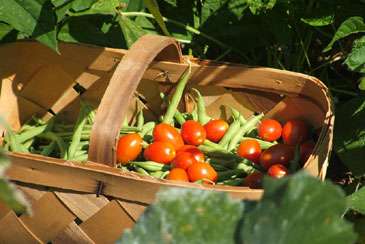Landscaping with a Green Thumb: The Vegetable Garden

In this article, you will find:
Getting started
Landscaping with a Green Thumb: The Vegetable Garden
With produce prices spiraling ever higher, it's a great time to consider planting your own vegetable and herb garden. If you have a sunny spot in your yard, or even just a sunny deck, you can grow your own organic produce, and always have fresh ingredients on hand for your family dinners.
Creating the Beds
You can grow an amazing variety of things in a relatively small space, with a bit of planning. Intensive planting in raised beds can be highly productive and requires less work than a large, tilled garden. That's because plants grown close together will require less weeding, and watering is simpler, as well.
There are many kits available for raised beds, but you can easily make your own with just a few tools. A good size for each bed is 6'L x 4'W x 10"H. Natural cedar is rot-resistant, and boards made from recycled plastic will last even longer. Do not use pressure-treated wood, creosote-treated wood, or landscaping ties, because toxic chemicals will leach into your soil. You can use cement blocks, though they will raise the soil pH over time.
Choose a level spot that gets sun at least five or six hours per day. For convenience's sake, the closer the beds are to a water source and your kitchen door, the better. Avoid locating your garden near trees and shrubs, whose roots could steal moisture and nutrients from your vegetables.
You should position your rectangular boxes in a north-to-south orientation, for balanced sun exposure. Leave enough room around them for a path—three feet wide is ideal. You will be working mostly from the path, because walking on the raised beds will compact the soil. Use a knee-friendly mulch such as shredded bark on the path, and you won't have to weed or mow it.
Inside each box, lay down a several layers of newspaper to prevent the roots of existing grass and weeds from invading your new soil—the newspaper will break down over time. Then fill each box with good, organic topsoil. Add some well-aged manure and/or compost on top. Allow the soil to settle for a week and add more, if needed. Now it's ready for planting!
If your growing space is limited to a sunny deck, you can grow vegetables and herbs in containers. Containers can be plain or fancy—many people just use galvanized or plastic tubs. You may need to punch several holes in the bottom (or put at least several inches of gravel below the soil) to ensure good drainage. Note that the containers will be heavy once they're filled with soil, so position them where you want them before filling them. It's also a good idea to raise the containers up slightly to allow good air circulation and drainage, and to prevent damage to your deck. Look for products such as pot feet, pot pads, and heavy-duty dollies and stands at your local garden supply center. Self-watering containers—containers that store water and keep soil moist for as long as a week—make growing vegetables nearly effortless.
If you don't have a compost pile already, now is the time to start one. Compost will work magic in your vegetable garden, enabling healthy, productive plants.

